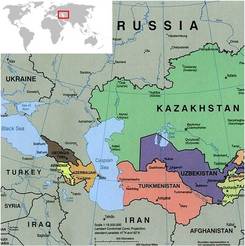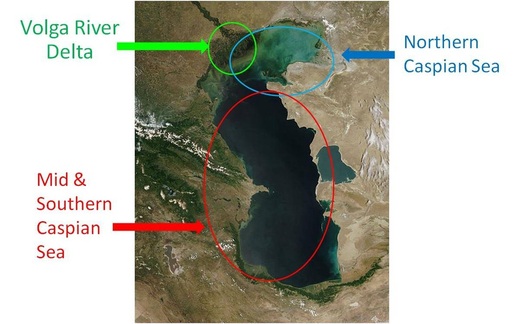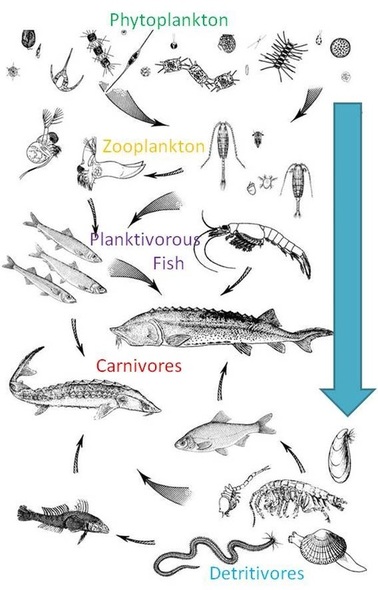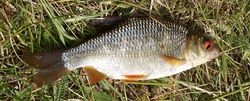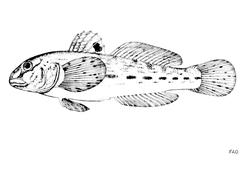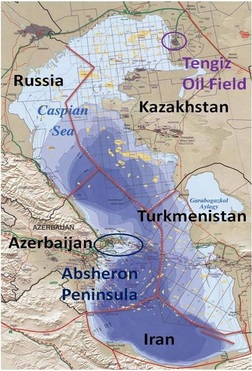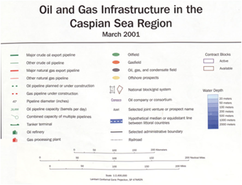The Caspian Sea
Introduction
The Caspian Sea is a brackish sea/lake located in central Asia. The sea is home to a wide range of species and may be best known for its caviar and oil industries. During the 20th and 21st centuries the Caspian Sea has been modified and changed by humans in many ways. Fish populations in the Caspian Sea have been largely depleted by human activities. Pollution from the oil industry and dams on rivers draining into the Caspian Sea have had negative impacts on the organisms living in the sea.
Basic Information
The Caspian Sea is the largest fully enclosed body of water in the world. Its surface area is approximately 390,000 km2 with an average depth of 208m [1]. The maximum depth of the sea is 1025m [1]. The Caspian sea sits 27m below sea level and is approximately 1/3 the salinity of the worlds oceans [1].The Caspian Sea is located in central Asia and bordered by Azerbaijan, Iran, Turkmenistan, Kazakhstan, and Russia. 130 rivers flow into the Caspian Sea however 90% of the freshwater input into the sea comes from the five largest rivers (the Volga, Ural, Terek, Sulak, and Kura) [3]. There are no outflows out of the sea with the exception of evaporation [1].
Back to Top
Biodiversity and Habitats
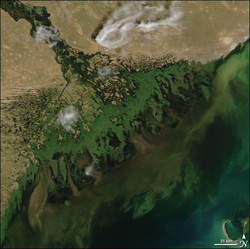
Volga River Delta [6]
The Caspian Sea can be divided into several distinct regions. The Volga river delta is freshwater and home to freshwater algae, many species of waterfowl, and fresh water fish including carp, pike, and catfish [1] The salinity in this region only reaches 0.1 [3] . In the Northern region of the sea brackish water species are able to survive including goby and sprat [1]. The northern region of the sea is also home to the Caspian seal which uses ice flows which form in this portion of the sea for breeding [2]. Here the salinity is variable and can range from almost fresh water to a salinity of 10 [3]. Marine species of fish and plankton generally dominate the central and southern portions of the Caspian where the salinity ranges from 10-14 [3]. These species include Caspian salmon, sturgeon, and herring [1]. Caspian salmon (actually a species of trout) and Sturgeon also migrate up rivers such as the Volga and Ural for spawning. In total there are 733 species of plants including 449 species of phytoplankton, 1069 species of free living invertebrates, 100 fish species, 312 species of waterfowl, and 1 species of mammal found in the Caspian Sea [1].
Regions of the Caspian Sea
Back to Top
Food Webs and Major Organisms
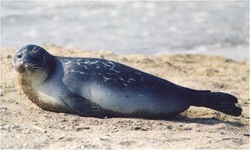
Caspain Seal [3]
Major organisms in the Caspian Sea include the Caspian Seal, several sturgeon species, and kilka, an important fishery in the sea [1]. Food webs in the Caspian Sea are similar to those of ocean food webs. Primary producers include fresh water as well as marine algae and phytoplankton. These are eaten by zooplankton and planktivorous fish which are in tern eaten by carnivorous fish, birds, and seals [1]. In the northern region of the sea primary productivity is driven by freshwater algae while in the central and southern regions productivity is driven by marine phytoplankton. This results in increased primary productivity in the northern region of the Caspian sea [1].
Back to Top
Historic Use
a
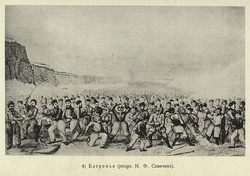
Traditional Sturgeon Ice Fishing [9]
The Caspian Sea has been utilized by people for hundreds of years, predominantly as a source of fish, though more recently it has been utilized for its oil and natural gas resources [1]. The Persian Empire began extracting oil from the shores of the Caspian Sea as early as the 1500's however modern development of oil fields did not begin until 1875 [5]. The rivers draining into the Caspian have also been utilized for hydroelectric power since 1958 [3].
Back to Top
Habitat Changes
a
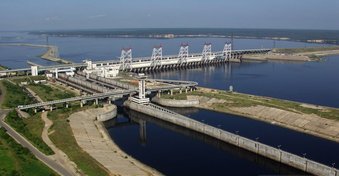
Cheboksary Dam on the Volga River [10]
Since 1958 many of major rivers which flow into the Caspian Sea have been dammed or have had water reallocated to other purposes. [3]. Freshwater discharge into the sea has been reduced by over 41 cubic kilometers per year [6]. This has negatively impacted anadromous fish species such as sturgeon by preventing them from reaching their freshwater spawning grounds. Its estimated that over the last 10 years anadromous fish stocks have declined by more than 11 times when compared to the period between 1930-1952 [6]. various sturgeon species found in the Caspian have lost 60-85% of their spawning grounds due to dam construction [3]. There are 325 dams on rivers draining into the Caspian Sea in Russia alone [6]. Dams have reduced flooding, a phenomena which many fish species rely on to reach their spawning grounds, on many rivers flowing into the Caspian Sea negatively impacting many fish species [6]. The Ural river remains the only major river which drains into the Caspian sea which has not been dammed [3]. Pollution from various industrial and agricultural sources has also had an impact on the Caspian Sea environment since 1970 [3].
Back to Top
Major Fisheries
Sturgeon
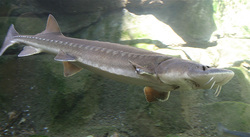
[11]
The Caspian Sea is home to six species of sturgeon all of which are fished commercially [4]. The eggs from these fish, known as caviar, is harvested and can be worth up to $2500 per kilogram as in the case of beluga sturgeon [5] and the Caspian Sea provides 90% of the worlds caviar [5]. The peak catch of Beluga sturgeon occurred in the early 1900's reaching 14,800 tonnes [4]. The current annual catch of Beluga sturgeon in the Caspian Sea is about 155.4 tonnes per year [4]. Beluga sturgeon stock has declined to about 10% of the population size present two decades ago [5].
Kilka
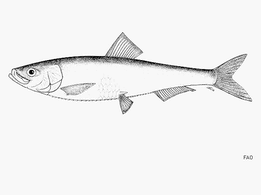
[12]
Kilka are a small, planktivorous, herring like fish native to the Caspian Sea [7]. There are three commercially fished species of kilka in the Caspian sea however several factors have resulted in the decline of this species. Kilka account for 80% of the total catch in the Caspian Sea [7]. The introduction of the ctenophore Mnemiopsis leidyi contributed to the decline of kilka by consuming much of the zooplankton which the kilka consume [1] however overfishing is also considered to be a major cause of the kilka decline in the Caspian [7]. During the 1970's and 80's the kilka catch reached 400,000 tons per year [7], a number which has been reduced to 54,300 tons annually [7].
Back to Top
Fisheries Management
Each of the five countries bordering the Caspian Sea has their own regulations for various fisheries. The Caspian Sea is not subject to the 1982 Law of the Sea which established exclusive economic zones for the waters surrounding most countries [1]. The waters of the Caspian Sea are considered international waters in which fishing regulations are often poorly enforced [1]. It is estimated that 750 tons of sturgeon are fished illegally every year [1], and that the illegal caviar industry grossed $400 million in 2002 [5]. In 1992 the Commission of Aquatic Bio-resources of the Caspian Sea was formed with the membership of Kazakhstan, Russia, Azerbaijan, Iran, and Turkmenistan and the goals of development and implementation of joint programs for conservation and the use of shared sturgeon stocks, kilka and seals, and also to conduct joint research studies addressing different hydro-biological aspects of the Caspian Sea [3].
Back to Top
Introduced Species
a
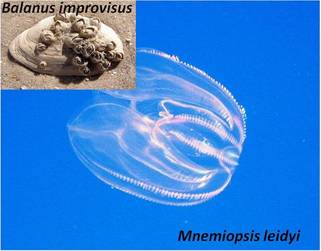
[15]
There have been several species introduced to the Caspian sea with the majority coming from the Black Sea. Many species were purposefully introduced to the Caspian Sea in the early 20th century for commercial purposes however many such introductions were unsuccessful [1]. Several species of invertebrates including Mytilaster lineatus and Balanus improvisus were introduced into the Caspian Sea as part of the boat fouling community in 1919 and 1955 respectively [1]. The majority of Invasive species in the Caspian Sea have had minimal impact on native species with the exception of the introduced ctenophore Mnemiopsis leidyi. M. leidyi, a species native to the Atlantic coast of north America, was first observed in the Caspian Sea in 1998 [5] and became established shortly afterwords. The species is belived to have come into the Caspian from the Black Sea by means of the Volga-Don canal [5]. This planktivorous ctenophore reduced the zooplakton density in the Caspian 5-6 times by 2000 [1]. This in turn caused a sharp decrease in planktivorous fish such as kilka, a small but commercially important species [1]. A decline in kilka is also bad news for seals which feed primarily on this fish [5]. M. leidyi may be responsible for entire foodweb changes in the Caspian Sea [7].
Back to Top
Pollution
There are several sources of pollution in the Caspian Sea. A major source coming from inland rivers is sewage discharge [6]. Various Industries, especially the oil industry, and agriculture have also been sources of pollution in the Caspian sea since the 1970's [3]. by 1990 concentrations of agricultural pesticides in fish tissues were documented at 2-8 mg/kg and heavy metals in sturgeon livers had reached 10-13 times permissible levels [3]. The oil industry has resulted in the release of petroleum hydrocarbons into the water however it is not yet known what the negative effects of this has been on the Caspian Sea Ecosystem [1].
Back top Top
Oil
History
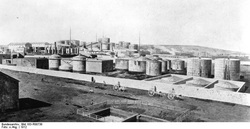
Nobel Brothers Petroleum oil tanks [17]
The Persians were the first to extract Caspian Sea oil on a large scale beginning in the 1500's [5] however commercial drilling did not begin until 1875 when Ludvig and Robert Nobel began drilling near Baku in present day Azerbaijan [5]. Within a decade oil production from the region jumped to 1 million tons of oil annually [5]. When Azerbaijan was absorbed into the Soviet Union Nobel brothers Oil was forced out of the region [5]. While under soviet control many oil fields in the Caspian were not heavily exploited. The soviets instead focused on extracting Siberian oil [5]. With the collapse of the Soviet Union western investments in Caspian oil poured into the region resutling in the oil industry which exists in the Caspian Sea region today [5].
Oil Fields
The resources of the seafloor of the Caspian, including oil reserves, have been divided between the five bordering countries [1].There are many major oil fields in the Caspian Sea region the largest of which is the Tengiz oil field located in Kazakhstan [2]. There are an estimated 750 million tons of oil yet to be extracted from the Tengiz oil field [2]. The Absheron peninsula is also an important area for oil extraction in the region and is where the modern oil industry in the Caspian Sea region began [2].
Oil Disasters
- 1983-Drilling rig 60 Let Azerbaijanu sinks containing 187 tons of diesel fuel, 29 tons of machine oil, and 300 tons of chemical reagents [1].
- 1985-Tengiz oil field explosion causes a well to burn for 398 days before the fire was extinguished [1]. Firefighters were unable to approach and put out the fire due to hydrogen sulfide gas, a toxic substance, which was also leaving the well [1].
- 2002-Cargo-passenger ferry Merkuriy sinks spilling 1080 tons of oil into the Caspian Sea [1].
Back to Top
Potential Solutions To Environmental Problems
Little is currently being done to solve the environmental problems of the Caspian Sea however there are some things that could improve the Caspian Sea environemt. Several things that could be done which could possibly improve fisheries and alleviate pollution in the Caspian Sea include......
- Better enforcement of fishing regulations
- Fish ladders to give anadromous fish access to spawning grounds
- Stricter regulations regarding oil extraction and refinement
Back to Top
References
[1] Kostianoy A. G., Kosarev A. N. 2005. The Caspian Sea Environment. Springer- Verlag Berlin Heidelberg.
[2] Zonn I. S., Kostianoy A. G., Kosarev A. N. The Caspian Sea Encyclopedia. 2010. Springer-Verlag Berlin Heidelberg.
[3] Pourkazemi M. 2006. Caspian Sea sturgeon Conservation and Fisheries: Past present and Future. Journal of Applied Ichthyology. 22, 12-16.
[4] Pikitc E. K., et.al. Status, trends and management of sturgeon and paddlefish
fisheries. Fish and Fisheries. 6, 233-265.
[5] Stone R. 2002. Caspian Ecology Teeters on the Brink. Science. 295, 430-434.
[6] Dubinina V. G., Kozlitina S. V. 2000. Water resources management of the southern
rivers of Russia with reference to fisheries requirements. Fisheries Management and Ecology. 7, 157-165.
[7] Daskalov G. M., Mamedov E. V. 2007. Integrated fisheries assessment and possible causes for collapse of anchovy kilka in the Caspian Sea. ICES Journal of Marine Science. 64, 503-511
[2] Zonn I. S., Kostianoy A. G., Kosarev A. N. The Caspian Sea Encyclopedia. 2010. Springer-Verlag Berlin Heidelberg.
[3] Pourkazemi M. 2006. Caspian Sea sturgeon Conservation and Fisheries: Past present and Future. Journal of Applied Ichthyology. 22, 12-16.
[4] Pikitc E. K., et.al. Status, trends and management of sturgeon and paddlefish
fisheries. Fish and Fisheries. 6, 233-265.
[5] Stone R. 2002. Caspian Ecology Teeters on the Brink. Science. 295, 430-434.
[6] Dubinina V. G., Kozlitina S. V. 2000. Water resources management of the southern
rivers of Russia with reference to fisheries requirements. Fisheries Management and Ecology. 7, 157-165.
[7] Daskalov G. M., Mamedov E. V. 2007. Integrated fisheries assessment and possible causes for collapse of anchovy kilka in the Caspian Sea. ICES Journal of Marine Science. 64, 503-511
Image References
[1] http://commons.wikimedia.org/wiki/File:Caspian_Sea_from_orbit.jpg
[2] http://commons.wikimedia.org/wiki/File:Oil_Rocks_near_Baku.jpg
[3] http://commons.wikimedia.org/wiki/File:Caspian_Seal.jpg
[4] http://commons.wikimedia.org/wiki/File:Каcпийcкoe_mope.jpg
[5] modified from: http://commons.wikimedia.org/wiki/File:Caucasus_central_asia_political_map_2000.jpg
[6] http://commons.wikimedia.org/wiki/File:VolgaDelta_AMO_2005jun11.jpg
[7] modified from: http://en.wikipedia.org/wiki/File:Caspian_Sea_from_orbit.jpg
[8] modified from Kostianoy, 2005
[9] http://commons.wikimedia.org/wiki/File:Багренье.jpg
[10] http://commons.wikimedia.org/wiki/File:Cheboksary-Ges.jpg
[11] http://commons.wikimedia.org/wiki/File:Sturgeon.jpg
[12] Whitehead, P.J.P. http://www.fishbase.org/Photos/PicturesSummary.php?StartRow=0&ID=1470&what=species&TotRec=2
[13] http://commons.wikimedia.org/wiki/File:Common_Roach.JPG
[14] Bauchot, M.-L. 1987 http://www.fishbase.org/Photos/PicturesSummary.php?StartRow=2&ID=12019&what=species&TotRec=6
[15] modified from: http://commons.wikimedia.org/wiki/File:Mnemiopsis_leidyi.jpg and http://commons.wikimedia.org/wiki/File:Balanus_improvisus_on_Mya_arenaria_shell.jpg
[16] Deutsches Bundesarchiv http://commons.wikimedia.org/wiki/File:Bundesarchiv_Bild_183-R00738,_Baku,_Erdöl-Tanks.jpg
[17] modified from http://commons.wikimedia.org/wiki/File:Caspian_sea_oil_gas-2001.jpg
[18] modified from http://commons.wikimedia.org/wiki/File:Caspian_sea_oil_gas-2001.jpg
[2] http://commons.wikimedia.org/wiki/File:Oil_Rocks_near_Baku.jpg
[3] http://commons.wikimedia.org/wiki/File:Caspian_Seal.jpg
[4] http://commons.wikimedia.org/wiki/File:Каcпийcкoe_mope.jpg
[5] modified from: http://commons.wikimedia.org/wiki/File:Caucasus_central_asia_political_map_2000.jpg
[6] http://commons.wikimedia.org/wiki/File:VolgaDelta_AMO_2005jun11.jpg
[7] modified from: http://en.wikipedia.org/wiki/File:Caspian_Sea_from_orbit.jpg
[8] modified from Kostianoy, 2005
[9] http://commons.wikimedia.org/wiki/File:Багренье.jpg
[10] http://commons.wikimedia.org/wiki/File:Cheboksary-Ges.jpg
[11] http://commons.wikimedia.org/wiki/File:Sturgeon.jpg
[12] Whitehead, P.J.P. http://www.fishbase.org/Photos/PicturesSummary.php?StartRow=0&ID=1470&what=species&TotRec=2
[13] http://commons.wikimedia.org/wiki/File:Common_Roach.JPG
[14] Bauchot, M.-L. 1987 http://www.fishbase.org/Photos/PicturesSummary.php?StartRow=2&ID=12019&what=species&TotRec=6
[15] modified from: http://commons.wikimedia.org/wiki/File:Mnemiopsis_leidyi.jpg and http://commons.wikimedia.org/wiki/File:Balanus_improvisus_on_Mya_arenaria_shell.jpg
[16] Deutsches Bundesarchiv http://commons.wikimedia.org/wiki/File:Bundesarchiv_Bild_183-R00738,_Baku,_Erdöl-Tanks.jpg
[17] modified from http://commons.wikimedia.org/wiki/File:Caspian_sea_oil_gas-2001.jpg
[18] modified from http://commons.wikimedia.org/wiki/File:Caspian_sea_oil_gas-2001.jpg
